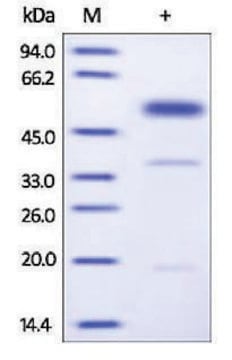The reconstituted product is stable for 1 month at –20 °C and for at least 2 months at –70 °C. Product 528205, a prepared solution, also stored at -70°C, is assigned a retest schedule of every two years. See the link below to review this product page:
https://www.sigmaaldrich.com/US/en/product/mm/528205
A8111
Plasminogen activator inhibitor 1 (PAI-1)
≥200,000 units/mg protein, lyophilized powder, ≥90% (SDS-PAGE)
Sinônimo(s):
PAIE, PLANH1, Plasminogen activator inhibitor, β-migrating endothelial cell-derived type, Serpin E1 PAI-1, Serpine 1
Selecione um tamanho
R$ 2.143,00
Selecione um tamanho
About This Item
R$ 2.143,00
Produtos recomendados
Nome do produto
Plasminogen activator inhibitor 1 (PAI-1) human, recombinant, expressed in E. coli, ≥90% (SDS-PAGE)
recombinante
expressed in E. coli
Nível de qualidade
Ensaio
≥90% (SDS-PAGE)
Formulário
lyophilized powder
atividade específica
≥200,000 units/mg protein
peso molecular
~43 kDa
solubilidade
water: 0.1 mL, clear, colorless
nº de adesão UniProt
Condições de expedição
dry ice
temperatura de armazenamento
−20°C
Informações sobre genes
human ... SERPINE1(5054)
Procurando produtos similares? Visita Guia de comparação de produtos
Descrição geral
Aplicação
- as an inhibitor of pro-brain-derived neurotrophic factor (proBDNF) in radioimmunoprecipitation assay (RIPA) in peripheral blood and lymphocytes[3]
- to block plasmin activation in mice infected with C. albicans hyphae[4]
- to test its effect on neurite growth in neurons[5]
Ações bioquímicas/fisiológicas
Definição da unidade
forma física
Reconstituição
Nota de análise
Código de classe de armazenamento
10 - Combustible liquids
Classe de risco de água (WGK)
WGK 1
Ponto de fulgor (°F)
Not applicable
Ponto de fulgor (°C)
Not applicable
Escolha uma das versões mais recentes:
Certificados de análise (COA)
Não está vendo a versão correta?
Se precisar de uma versão específica, você pode procurar um certificado específico pelo número do lote ou da remessa.
Já possui este produto?
Encontre a documentação dos produtos que você adquiriu recentemente na biblioteca de documentos.
Os clientes também visualizaram
Artigos
Lipid Induced Insulin Resistance
-
Once it has been reconstituted, what is the recommended storage temperature? Will the reconstituted liquid be stable at 4 C for short-term storage (e.g. <24 hrs)?
1 answer-
Helpful?
-
Active Filters
Nossa equipe de cientistas tem experiência em todas as áreas de pesquisa, incluindo Life Sciences, ciência de materiais, síntese química, cromatografia, química analítica e muitas outras.
Entre em contato com a assistência técnica











